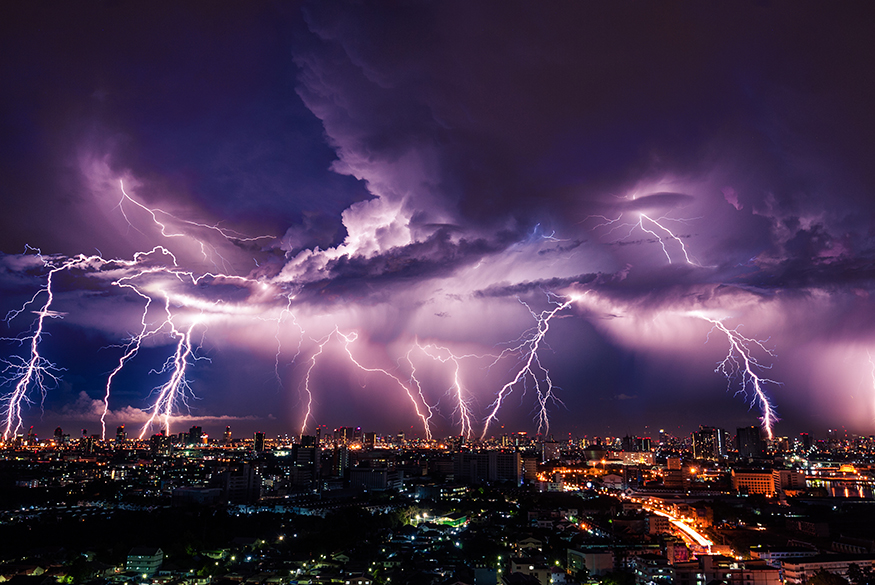Lightning Protection
The National Fire Protection Association (NFPA) estimates that each year, U.S. Fire Departments respond to over 31,000 fires started by lightning strikes. In addition, Underwriters Laboratories (UL) notes that lightning causes more than $1 billion in structural damage every year in the U.S. However, lightning damage is categorized as a preventable by the Insurance industry.
Is your property safe? You can ensure that your building won’t be damaged by lightning this year if proper lightning protection is installed. A certified lightning protection system provides a safe path for lightning to travel to the ground, which protects your building from lightning damage.
If lightning had affected your building, you would see structural damage such as:
- Fires, ignited by lightning;
- Scorched Electronic equipment;
- Exploded masonry/concrete walls; and
- Burn-holes in exterior metal surfaces.
Structural damage is not the only issue caused by lightning. Lightning affects your property more than you know:
- Does your building experience intermittent issues in the electrical system?
- Are data systems in the building experiencing “glitches” during weather events?
- Does your energy management system need to be reset after electrical storms?
- Is your access control system exhibiting quirks after lightning strikes in the area?
It may be that the maintenance staff is diligent in checking these systems, and has come to expect intermittent issues. This may be as simple as resetting a circuit breaker, cycling power to rooftop HVAC units, or even as easy as clicking “reset” on the control software; but, these may all be signs that atmospheric electricity is discharging through your building. This electrical energy decides on its own path to take, and thus often causes damage to building systems.
“BUT MY BUILDING ISN’T VERY TALL…DO I REALLY NEED LIGHTNING PROTECTION?”
Lightning does more to buildings than simply striking them; lightning strikes in the area can also affect your building systems and services. Proper lightning protection protects your water, natural gas and electric service from electrical energy generated by nearby lightning strikes.
In addition, every building is a possible target for lightning strikes. Remember: lightning chooses its own path to the ground. The only way to ensure that your building is protected is to have correctly installed lightning protection by a manufacturer-approved installer. Furthermore, pursuing a UL Master Label through your installer and UL will ensure that your installer is using a complete, integrated system.
ARE YOU PROTECTED?
Your building may have some form of lightning protection, but has it been installed according to NFPA and UL Standards? Lightning protection has improved in the last decade to reflect recent understanding of lightning strikes and how to protect buildings and their affected systems from this force. A properly implemented lightning protection system ensures that your building is protected from direct lightning strikes, indirect strikes, strikes affecting electrical, water, natural gas service and the discharge of accumulated static electricity from wind.
While it’s true that surge protectors provide some measure of protection for electronics, they should be viewed only as having limited protection and only for electronic devices. Even the best surge protection cannot protect a building from lightning damage, nor can it guarantee that electronics will not be adversely affected.
The most common issues caused by lack of proper lightning protection are often brushed aside as routine glitches. This happens when electrical energy from the atmosphere discharges through a structure, affecting electrical and electronic systems. Often these are caused by a buildup of static charge during high winds, which finds its own haphazard path to earth. When these systems are not functioning properly, the ability to provide consistent functionality of building systems is diminished. What if the energy management system failed to activate HVAC systems in the morning because of electrical storms during the previous night? Think of what the loss of functionality in access control systems during inclement weather would mean for your business.
ENSURE THAT YOU ARE ALWAYS PROTECTED
If your lightning protection was installed according to NFPA standards, or has received a UL Master Label for the entire facility, or letter of findings for a portion there-of, that does not mean that you are still protected. Contractors, service personnel, high winds and time can degrade or weaken your lightning protection. Having the approved installer make annual visits to inspect the lightning protection is key. This allows you to be sure that your system will function 100 percent correctly during a lightning strike on your building.
Proper lightning protection prevents all of these troublesome issues, in addition to protecting your building from the potential fires, building damage and risk that comes from lightning strikes.
NFPA and UL are at the forefront of modern Lightning Protection. To ensure a building is protected, insist on two things: the lightning protection is installed by an approved installer of a reputable manufacturer’s systems and the system meets these standards, year-round with annual inspections by the approved installer.
Choose a reputable lightning protection products manufacturer, and then select one of their approved installers to address your needs. Seek a UL listing through the installer, who will have the installation approved by a UL inspector. Receiving a UL listing by Underwriters Laboratories’ approved inspectors is inexpensive, and ensures that your lightning protection system will be in general compliance with the best applicable standards in the industry to protect your building.
ABOUT THE AUTHOR
Lance LaJoie is a Facilities Safety Specialist in the Nashville Branch of PENTA Engineering Group, a UL-Listed Installer of Lightning Protection systems, where he installs, inspects and repairs Lightning Protection systems in accordance with NFPA and UL standards. He also performs OSHA and IWCA required testing for tie-back anchors and davit systems. He has over 10 years of residential and commercial construction experience, including the installation and diagnosis of Building Envelope systems. He has five years of experience in the Maintenance—Property Management field for Class A Office buildings. Driven to meet the needs of property managers, owners, and maintenance teams, he strives to provide quality service and excellent workmanship.









